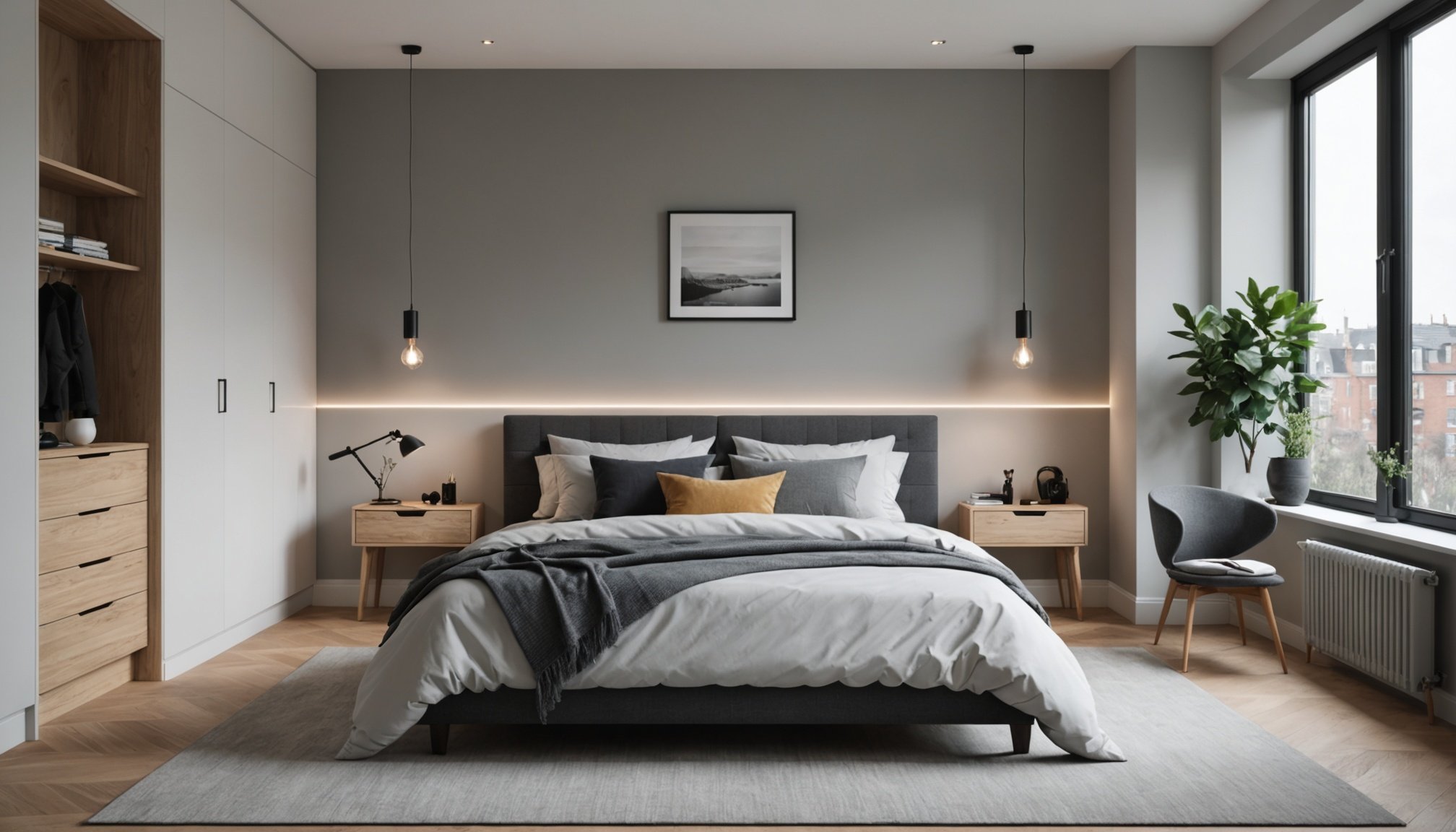Creating a cozy minimalist bedroom in a modern UK apartment hinges on balancing simplicity with warmth. A well-thought-out design can transform limited space into a soothing sanctuary. By focusing on functional furniture, soft textures, and a serene color palette, you can maximize comfort without clutter. Discover practical tips to craft a minimalist bedroom that not only serves its purpose but also reflects your personal style and promotes relaxation. Embrace the freedom of minimalism while enhancing your living space's coziness.
Understanding Minimalism in Bedroom Design
Minimalism in bedroom design embraces simplicity and functionality, focusing on creating a serene and uncluttered environment. At its core, minimalism is about stripping down to the essentials, allowing each element to serve a purpose. This approach not only enhances the modern aesthetics of a space but also promotes a sense of calm and order.
Cela peut vous intéresser : Transform Your UK Home into a Tranquil Sensory Garden: A Step-by-Step Guide to Ultimate Relaxation
Principles of Minimalist Design
The principles of minimalist design include clean lines, neutral colour palettes, and a focus on quality over quantity. By choosing a few key pieces, such as a sleek bed frame or a simple nightstand, you can create a cohesive and harmonious look. The aim is to highlight the beauty of each item without overwhelming the space.
Benefits of a Minimalist Bedroom
A minimalist bedroom offers several benefits. It encourages better sleep by reducing distractions and clutter. Moreover, it simplifies cleaning and maintenance, saving you time and effort. With fewer items, you can also invest in higher-quality pieces, leading to a more sustainable and long-lasting design.
A lire en complément : Transform Your UK Master Bedroom: 10 Steps to Crafting a Lavish En-Suite Bathroom
Common Misconceptions about Minimalism
One common misconception is that minimalism equates to stark and cold spaces. However, a minimalist bedroom can be warm and inviting by incorporating textures and personal touches. Another myth is that minimalism is restrictive, but it actually provides the freedom to focus on what truly matters.
Space Planning for Small UK Apartments
Designing UK apartments requires strategic space planning to ensure functionality and comfort. Begin by thoroughly assessing the available space, noting architectural features, natural light sources, and traffic flow. This assessment is crucial for understanding how to best utilise each area.
Functionality is paramount in room layout. Prioritise spaces that serve multiple purposes, such as a living room that doubles as a home office. This approach maximises utility without compromising on style. Consider the placement of furniture to maintain a seamless flow, ensuring that each piece enhances the room's purpose.
For maximising small spaces, opt for furniture with built-in storage, like beds with drawers or coffee tables with shelves. These pieces help reduce clutter while maintaining a minimalist aesthetic. Use vertical space effectively by installing shelves or cabinets that draw the eye upward, creating an illusion of height.
Incorporating mirrors can also amplify the sense of space by reflecting light and opening up the room. Additionally, choose a neutral colour palette to maintain a bright, airy feel, making the apartment appear larger. Thoughtful interior layout decisions can transform small UK apartments into functional, stylish homes.
Choosing the Right Colour Palette
Selecting the appropriate colour palette is crucial in crafting a minimalist bedroom that radiates a cozy atmosphere. Popular schemes often feature neutral tones like whites, greys, and beiges, which enhance the sense of space and serenity. These hues create a timeless backdrop that complements the simplicity of minimalist design.
How Colours Affect Mood and Perception of Space
Colours play a significant role in influencing mood and the perception of space. Light shades can make a room feel larger and more open, while darker tones add depth and intimacy. For a calming effect, opt for soft blues or greens, which are known to reduce stress and promote relaxation. Warm colours, such as muted yellows or terracottas, can introduce warmth without overwhelming the minimalist aesthetic.
Tips for Incorporating Accent Colours
Incorporating accent colours can add personality and interest to a minimalist bedroom. Consider using bold colours sparingly through artwork, cushions, or rugs. This approach maintains the minimalist ethos while allowing for personal expression. A cohesive look can be achieved by selecting one or two accent colours that complement the primary palette, ensuring balance and harmony within the space.
Selecting Furniture for Comfort and Functionality
Choosing the right furniture selection is crucial for achieving both comfort and functionality in a minimalist bedroom. The key is to focus on essential pieces that offer space-saving solutions. A minimalist bedroom typically includes a bed, nightstand, wardrobe, and possibly a chair or small desk. Each piece should serve a purpose without cluttering the space.
Essential Furniture Pieces
For a minimalist approach, select a bed with clean lines and built-in storage, such as drawers or a lift-up base. This space-saving feature maximises utility and keeps the room tidy. A simple nightstand with a drawer can provide necessary storage without overwhelming the space.
Multifunctional Furniture
Incorporate multifunctional furniture to enhance comfort and functionality. Consider a wardrobe with integrated shelving or a desk that doubles as a vanity. These pieces adapt to various needs, making them ideal for compact spaces.
Scale and Proportion
Pay attention to the scale and proportion of each furniture piece. Oversized items can dominate a room, disrupting the minimalist ethos. Opt for furniture that complements the room's dimensions, ensuring a balanced and harmonious look. This careful consideration enhances both the aesthetic and practical aspects of the bedroom.
Textiles and Soft Furnishings for Coziness
Enhancing the coziness of a minimalist bedroom involves thoughtful selection of textiles and soft furnishings. These elements add warmth and texture, crucial for creating an inviting space.
Choosing the Right Bedding Materials
Opt for bedding materials that offer both comfort and style. Natural fibres such as cotton or linen are excellent choices, providing breathability and a soft touch. These materials complement the minimalist aesthetic while ensuring a restful night's sleep. Consider layers like throws or duvet covers in neutral tones to add depth without cluttering the space.
Incorporating Rugs and Curtains for Warmth
Rugs and curtains are essential for introducing warmth and defining areas within the bedroom. A plush rug underfoot can soften hardwood floors and provide a cosy landing spot. Choose curtains in heavier fabrics to insulate against drafts and create a sense of privacy. Both elements contribute to a warm, inviting atmosphere, enhancing the room's overall comfort.
Balancing Texture and Minimalism
Achieving balance between texture and minimalism is key. Incorporate varied textiles subtly to maintain the minimalist ethos. For instance, a textured cushion or a knitted throw can add interest without overwhelming the space. This approach allows for personal expression, ensuring the bedroom remains both functional and serene.
Lighting Solutions for a Cozy Ambiance
Creating a cozy atmosphere in a minimalist bedroom involves thoughtful use of lighting. The right lighting can transform a space, enhancing its warmth and functionality.
Types of Lighting Suitable for a Minimalist Bedroom
In a minimalist bedroom, focus on three main types of lighting: ambient, task, and accent. Ambient lighting provides general illumination. Consider ceiling fixtures with clean lines or recessed lighting for a sleek look. Task lighting, such as reading lamps, is essential for specific activities. Accent lighting highlights features or artwork, adding depth without cluttering the space.
Layered Lighting Strategies
A layered lighting approach enhances a cozy atmosphere. Combine different light sources to create flexibility and mood. Use dimmers for ambient lights to adjust brightness according to the time of day or activity. Incorporate floor lamps or wall sconces to provide additional layers, ensuring the room remains inviting and functional.
Importance of Natural Light and Window Treatments
Natural light is crucial for a welcoming ambiance. Maximise it by using sheer curtains or blinds that allow light to filter through while maintaining privacy. Consider window treatments that complement the room's design, enhancing both aesthetic and practical elements. This balance ensures a harmonious and cozy atmosphere.
Incorporating Personal Touches Without Clutter
Integrating personal touches into a minimalist bedroom can be achieved without compromising its serene aesthetic. The key lies in selecting meaningful décor pieces that reflect your personality while maintaining a sense of minimal clutter.
To display personal items, consider using a curated approach. Choose a few cherished photographs or artworks and place them strategically to avoid clutter. Opt for frames with clean lines to complement the minimalist design. A small shelf can serve as a dedicated space for displaying these items without overwhelming the room.
When selecting meaningful décor pieces, focus on items that resonate personally. This could be a unique sculpture, a handmade vase, or a travel souvenir. These elements add character and warmth, making the space truly yours. Ensure each piece has a designated place, preventing the feeling of clutter.
Avoiding clutter while showcasing personality involves restraint. Limit the number of items on surfaces like nightstands or dressers. Use storage solutions, such as decorative boxes, to keep smaller items organised and out of sight. This approach allows you to express individuality while maintaining the minimalist ethos, ensuring a harmonious and inviting bedroom environment.
Solutions for Common Challenges in Minimalist Design
When embracing minimalist living, certain design challenges can arise, particularly in small spaces. Addressing storage issues is crucial. Opt for furniture with integrated storage solutions, like beds with drawers or ottomans that open up to store items. Wall-mounted shelves can also be a space-saver, providing vertical storage without taking up floor space.
A common fear in minimalist design is the emptiness that might feel uninviting. To overcome this, incorporate textures and layers to add warmth and depth. Use rugs, cushions, and throws in various materials to create a cosy environment without clutter. Personal touches, such as a few selected artworks or plants, can also bring life to a minimalist space.
Maintaining a minimalist lifestyle requires discipline and strategy. Regular decluttering is essential; set aside time each month to evaluate what is truly necessary. Adopt a "one in, one out" policy to prevent accumulation. Organise belongings by category and use labelled boxes or baskets to keep items tidy and accessible. These strategies ensure that a minimalist design remains functional and inviting, enhancing the overall living experience.
Visual Inspiration and Examples
Exploring visual inspiration is essential for crafting a minimalist bedroom that is both functional and inviting. By examining design examples, you can gain insights into successful layouts and decor choices that can be adapted to your own space.
Showcasing Successful Minimalist Bedroom Designs
Successful minimalist bedroom designs often highlight the beauty of simplicity. These spaces typically feature clean lines, neutral colour palettes, and a focus on functionality. For instance, a room with a sleek platform bed, a single piece of artwork, and a few well-placed plants can evoke a sense of calm and order. Such examples demonstrate how minimalism can create a cozy bedroom environment without sacrificing style.
Importance of Mood Boards in Planning
Creating a mood board is a valuable step in planning your minimalist bedroom. It allows you to visualise how different elements—such as colours, textures, and furniture—will work together. By compiling images and materials that resonate with your vision, you can ensure a cohesive and harmonious design.
Resources for Further Inspiration
For further inspiration, consider exploring books and websites dedicated to minimalist design. Publications like "Minimalist Interiors" or online platforms such as Pinterest offer a wealth of visual inspiration and design examples to guide your creative process.












